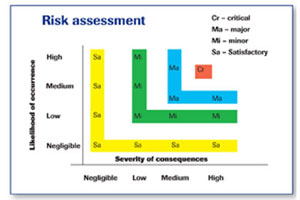Over the past two decades, there has been a paradigm shift in the relationships between food, beverage and ingredients processors and their vendors. Years ago, the role of purchasing was to find the necessary ingredients and raw materials at the best price. Today, processors must ensure what they order is safe, high quality and wholesome, and vendors must be able to prove all of these. In this way, quality and safety demands have been pushed further back in the food chain and are literally becoming a farm-to-fork exercise. The goal is to reduce risks coming into the plant and, therefore, potential liability.
Vendor quality and approval are elements of the Food Safety Modernization Act (FSMA). As a result, all US processors must establish a vendor quality program. One of the most important elements of the program will be assessing risk in ingredients, raw materials and packaging materials they currently use, as well as any new materials they are thinking about using. Risk assessments should be conducted by a processor’s HACCP or food safety team. Different tools are available for assessing risk, but one of most commonly used is a system where each ingredient or raw material is assessed as follows:
 • Severity of the hazard
• Severity of the hazard
• Probability of an adverse effect or likelihood of occurrence.
Different scales may be employed for each element. Some companies rank each element as negligible, low, medium or high. Others assign numerical values with descriptors for each. The chart below shows how the former can be used for assessing risk. For example, when using descriptors for severity, the lowest number would be defined as low risk with minor disappointments or no food safety risk. The highest number for severity would be defined as catastrophic and possibly resulting in death. The likelihood of occurrence ranges from one to 10, with one being “not possible.” These numbers are multiplied to give a risk rating. The lower the risk rating, the lower the risk, and vice versa. Many different factors must be incorporated into ingredients and raw materials risk assessments. These include, but are not limited to, the history of the ingredient, the processor manufacturing the ingredient, the country of origin, how the product was processed and handled, how it is packaged and how the material will be used. For example, a product such as shell eggs has a high potential risk, whereas eggs that have been pasteurized in the shells or pasteurized liquid eggs have a lower risk rating. Because of melamine issues with dairy ingredients from China, as well as Sudan Red concerns with capsicums from India, processors that buy these materials must acknowledge past issues and the potential risk, even though steps have been taken to abate these problems. Risk assessment should also include a supplier evaluation. Buyers usually demand to be allowed to audit a potential supplier or mandate a third-party audit. They also must establish minimum requirements for food safety, quality, sanitation and other elements of suppliers’ management programs. Any supplier that fails to meet these minimum requirements would be deemed a risk and, therefore, rejected.
Since every processor will be mandated to evaluate the potential risk of all ingredients, raw materials and packaging it purchases, a risk assessment should be an integral element of its vendor approval program—to protect the company’s good name, its products and its customers.



